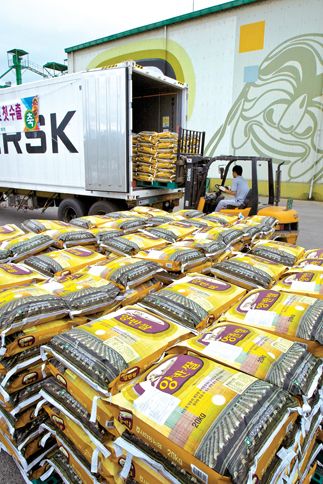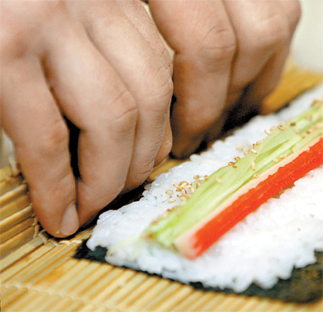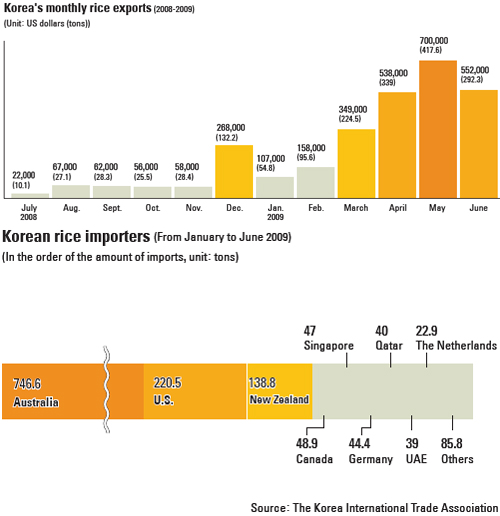Korean rice gains ground overseas

Bags of Andong Yangban Rice are stacked up and ready for export to Qatar.
The bags of rice, each of which had a label written in both English and Arabic, were ready for shipping and bound for Qatar. The 20-foot truck, which had arrived to pick the bags up and transport them to Busan Port, was decorated with a sign that read: “Celebrating the first shipment of Andong Yangban Rice to Qatar.”
“We’ve exported 260 tons of rice worth 550 million won [$437,195] to foreign markets since we started exporting Yangban Rice late last year,” Kim Mun-ho, director of Seo Andong Nonghyup, said. “Our overseas markets range from North America, including the United States and Canada, to Russia, Australia, New Zealand and Qatar.”
In describing the export process, Kim said, “The process has effectively been divided among three parties: We produce the high-quality rice, the Andong city government provides an export subsidy and NH Trading [a subsidiary of Nonghyup] is in charge of finding markets overseas.”
As seen with the case of Yangban Rice, Korea is now positioning itself as a rice exporter.
Korean rice exporters initially targeted Korean residents in foreign countries, but there is now a large demand for Korean rice among non-Koreans in foreign countries, particularly among sushi restaurants looking for high-quality rice. Korea exported 1,434 tons of rice in the first half of the year, a 12-fold increase from the same period a year ago, when 106 tons were exported. That translates into sales of $2.44 million this year, from $300,000 last year.
While the country’s total rice exports for this year are estimated to be between 2,500 and 3,000 tons, industry officials say that the figure is encouraging considering that Korean rice is a latecomer in foreign markets.
Korea began exporting rice just two years ago.
In the period following the country’s liberation from Japanese colonial rule in 1945 through the early 1970s, the exportation of rice was unthinkable due to continued fears of food shortages. The Korean War (1950-53) and the years that followed were particularly difficult. Most Koreans remember this period as the “barley hump,” a time in the 1960s when food was scarce and people had very little to eat.
The severe food shortages of the post-war years began to dissipate with the rapid increase in rice production spurred by the introduction of Tongil rice in 1971. The new rice variety, which was developed to improve the country’s self-sufficiency in food, boosted rice production by 50 percent.
Still, the Korean government continued to ban rice exports, citing concerns about food production.
It wasn’t until 1996, when the Grain Management Law was revised, that a legal provision for the exportation of rice was established. However, there were lingering concerns within the government that exporting rice would have an adverse effect on negotiations with other countries once the domestic rice market opened. The concern within the international community was that Korea would not import enough rice to accommodate local farmers.
It wasn’t until May 2007 that negotiations on the opening of the domestic rice market were concluded and restrictions on rice exports were lifted.
For the next seven months, Korea’s rice exports amounted to 566 tons, or $1.37 million.
Australia was the largest buyer of Korean rice, importing 747 tons of rice in the first half of the year, and it accounted for more than half (52 percent) of Korea’s total rice exports. Australia was followed by the United States (221 tons), New Zealand (139 tons), Canada (49 tons), Singapore (47 tons), Germany (44 tons) and Qatar (40 tons).

But with the price of American rice having risen to 53 Australian dollars per 50-pound bag, sales of Korean rice, which sells for 49 Australian dollars per 20-kilogram bag, have expanded, Hwang said.
What makes Korean rice so competitive is its high quality and low price, he added.
“We began supplying [Korean] rice to Sushi World, which operates about 40 sushi restaurant chains in Sydney, and the reaction has been good,” Hwang said. “We plan to make inroads to large local supermarket chains like Woolworths and Coles with smaller bags of rice [1-2 kilograms] when we get this year’s crop.”
The number of restaurants importing Korean rice is also increasing in the United States, Chang Chul-dong, 51, head of New York-based Hansung Food Co., said.
“Although Korean restaurants in the United States were more likely to use American rice in the past, those using rice from Korea are increasing in number, so now we are focusing on trading in Korean rice to meet the demand,” Chang said.

“American rice sells for about $1.32 per kilogram at large retail outlets, while Korean rice sells for around $2.25 in supermarkets run by Koreans. Because of the price difference, people who buy Korean rice are still mostly Koreans who want a taste of home,” Chang said.
In Europe, however, Korean rice appeals to locals as much as it does to Korean residents, industry sources say.
“We have exported 44 tons of rice to Germany so far this year, most of which we have sold to Japanese markets there,” Kim Yong-jae, a NH Trading official, said.

By Joo Jung-wan [spark0320@joongang.co.kr]










with the Korea JoongAng Daily
To write comments, please log in to one of the accounts.
Standards Board Policy (0/250자)